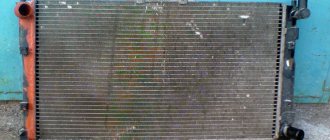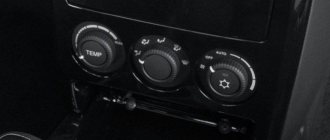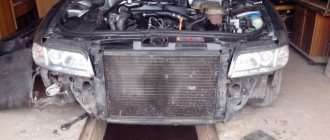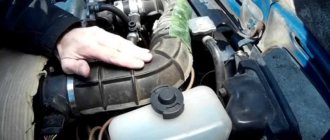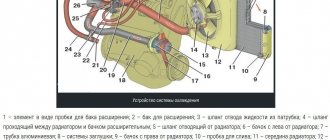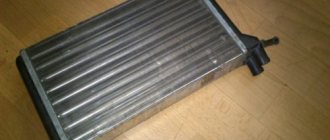Main reasons
In the summer, most likely, a stove breakdown will not be noticeable. And in winter, in sub-zero weather, the issue of heating comes to a head. A malfunction of the stove can be caused by the following reasons:
- malfunction of the thermostat or thermoelement;
- clogged radiator honeycombs;
- air pump impeller play;
- incorrect temperature sensor readings;
- jammed damper;
- breakage or rust on the regulator wire;
- coolant leak;
- air entry;
- poor quality antifreeze.
The stove is not the simplest car system. Finding the right problem is difficult and time-consuming, but possible. If you don’t want to pay at a car service center, you can figure it out yourself.
Thermostat doesn't work
The thermostat is an element of the car that controls the flow of coolant. These flows are needed to constantly cool the engine in any car. But in order for the engine to warm up faster, part of the coolant (coolant) is fenced off. If the thermostat is jammed and is constantly in this “open” state, then it moves the antifreeze in a large circle. In other words, the engine cools above normal and heats up very slowly.
Note! A thermostat malfunction is not immediately noticeable. If you drive at low speeds, you will hardly notice such a breakdown. But on the highway outside the city, cold air from the stove will not take long to arrive. The thermostat cannot be repaired; this part will have to be replaced with a new one.
Heater core clogged
Warm air blows into the cabin from the radiator. If the grille is clogged, air will not be able to enter in the required volume and at the required temperature. Despite the fact that the radiator of the heating system is located in the cabin, fluff and dust still get in and clog the mesh. In addition, there is antifreeze on the inside, which also clogs into the cells over time.
Important! Most often, the radiator becomes clogged due to the use of low-quality coolants. Therefore, changing the coolant to a more expensive one can benefit the car’s heating system.
Another cause of clogging is the formation of scale when water enters. Water is also corrosive. Also, the radiator grille becomes clogged when using sealant. After replacing the radiator, you can notice an improvement in the operation of the stove.
Note! During a visual inspection, this problem is almost impossible to recognize, so you will have to contact a car service. Also, the replacement process can take a whole day because there is a lot of work. Therefore, it is better to first exclude other causes and only then climb to the radiator of the heating system. The cost of cleaning the radiator grill reaches 2000 rubles or 700 UAH.
You can wash the old radiator with a special liquid and swap the pipe connections. But if you don’t want to bother with this, then you can replace the part with a new one in the service.
Pump worn out
Simple wear and tear can also affect the operation of the air pump. The impeller is rubbed, a gap is formed between the parts into which air passes. In other words, the air pump seems to be working, but the impeller cannot create enough pressure in the system. Of course, the stove still heats up and heat comes from it, but at low speed the coolant does not circulate enough through the system.
Note! In warm weather, such a breakdown may not be noticeable. The engine still heats the interior, and it is the heater that suffers. If cold air blows from the stove when moving slowly, but the situation gets better at high speed, it makes sense to check and replace the pump if necessary.
Temperature sensor failure
Since the conventional stove in cars has long been replaced by smart and modern electronics, many reasons for electronic malfunctions have appeared. If there is a glitch in the temperature sensor, then the system does not understand that it is necessary to heat the interior. The difficulty of this breakdown is that it is almost impossible for the driver to diagnose it. Especially if the fault is in the electronic part of the system. So all you have to do is go to a service station or call a specialist.
Air jams
Air jams lead to the same effect. They are formed when low-quality antifreeze boils. The gas stagnates in the thin tubes and creates a back pressure that prevents heat removal. This is dangerous, since engine cooling will be incomplete, resulting in local overheating of the cylinder head. An overheated engine is prone to damage to the combustion chambers and the appearance of scoring on their walls. Therefore, a poorly heating stove should not be ignored.
Question answer
How to turn on the car heater without breaking the windshield?
Diagnosis of the problem
In order to correctly diagnose a breakdown, you need to understand the structure of the system. The heater is inextricably linked to the car's cooling system. The engine heats the coolant, which then enters the heat exchanger with the fan. From there, the fan distributes warm air evenly throughout the cabin. Malfunctions may be as follows:
- the stove heats up, but warm air does not flow or only flows at high speed.
- the stove does not respond to temperature and the air is either only cold or only hot.
- The stove works, but the hot air does not blow.
Note! The banal reason is a lack of coolant. The antifreeze level should be regularly monitored. You also need to pay attention to the color of the coolant. If the fluid has changed color and is now rusty, then it needs to be changed. You can read about why antifreeze may leak here.
Water pump problems
In the event of a water pump malfunction, contamination or breakdown, the required coolant pressure is significantly reduced.
What to do?
It is necessary to remove the drive belt and examine it. Is it stuck or stretched? Are the rotations making noise or is there coolant dripping from the hole? The solution is to drain the coolant, remove the pump and replace it, because... The water pump cannot be repaired.
Lada Vesta/XRAY climate control system diagram
_x000D_
_x000D_
Air conditioning system Lada Vesta/XRAY: 1, 2, 5 — air conditioning system pipelines; 3 — air conditioning compressor drive belt; 4, 15 — hoses of the engine cooling system; 6 - engine; 7 — air conditioning filter; 8 — air conditioner electric fan; 9 — air conditioner evaporator; 10 — air conditioner housing; 11 — radiator of the heating system; 12 — heater radiator supply hose; 13 — heater radiator outlet hose; 14 — air conditioning compressor; 16 — fan of the engine cooling system; 17 — radiator of the cooling system; 18 - air conditioner condenser.
_x000D_
Problems with the climate control unit
Sometimes the stove does not heat well due to problems in the climate control unit. This may be due to a software failure, cable slipping, or mechanical wear of parts.
Climate control unit
The real cause can only be determined after diagnostics and partial disassembly of the panels with the control unit. In most cases, the problem can be solved with small repairs that you can do yourself.
The engine is heating up and the heater is blowing cold air.
- Links
- Bookmarks
- Unanswered topics
- Active topics
- Search
- our team
The engine gets hot and inside is like outside
- print version
Messages: 54 Registered: 02 Nov 2010, 00:00 Experience: 8 years
| Rating: 54 |
| Reputation: 0 |
The engine gets hot and inside is like outside
- Quote
Post by kovalchuck1 » Dec 19, 2010, 09:36 pm
Messages: 251 Registered: Apr 01, 2008, 00:00 From: Tyumen Experience: 06/15/2007 Car: ipsum sxm10 : Awards: 1
| Rating: 551 |
| Reputation: +2 |
Thanked: 2 times
- Quote
Post by saturn-z » Dec 19, 2010, 9:41 pm
Messages: 44 Registered: 09 Feb 2009, 00:00 From: Tyumen Experience: 2005 Car: nissan : Awards: 1
| Rating: 44 |
| Reputation: 0 |
- Quote
Post by shumiga » Dec 19, 2010, 09:41 pm
| Rating: 62 702 |
| Reputation: +83 |
Thanked: 277 times Thanked: 754 times
- Quote
Post by pesec » Dec 19, 2010, 9:41 pm
Messages: 3934 Registered: Dec 27, 2005, 00:00 From: Tyumen Experience: 2002 Car: Subaru legacy : Awards: 1
| Rating: 5 384 |
| Reputation: +3 |
Thanked: 5 times Thanked: 23 times
- Quote
Post by West2K » 19 Dec 2010, 21:44
Messages: 54 Registered: 02 Nov 2010, 00:00 Experience: 8 years
| Rating: 54 |
| Reputation: 0 |
- Quote
Post by kovalchuck1 » Dec 19, 2010, 9:44 pm
The top hose to the radiator is hot, but the bottom hose is generally cold! and by the way, I checked it, opened the expansion cap, gave it gas, but the return flow from the thin hose did not flow into the tank. I don't know what to blame, it's either the thermostat or the pump!
Cabin filter clogged
Another reason why the stove does not heat well is that the cabin filter is dirty. In most car models, it is located in a special locking box located behind the glove compartment. According to statistics, 45% of drivers ignore replacing this filter. However, over time, leaves, debris and just dust accumulate in it. This leads to the fact that air does not flow normally into the cabin, and the intensity of its flow decreases. Even if the radiator heats up well, a sufficient amount of air will not flow into the cabin.
Clogged cabin filter
You can fix the problem by checking the cabin filter. If it is dirty, it needs to be replaced. You can additionally clean the air duct with a vacuum cleaner or other convenient method. For better effect, you can try to stretch the tube to the heater radiator and blow it through with a compressor.
The stove began to heat poorly - the stove radiator was clogged
The heater radiator does not heat well in 1 out of 4 cases due to clogging. This is especially true for cars over 6-7 years old. There is a 90% chance that the service station will advise you to replace it, which is quite expensive and time-consuming. One solution to the problem is flushing the radiator.
Heater radiator
You can flush the radiator using special cleaning products or citric acid:
- To do this, water is heated in a bucket to a temperature of 80-90 degrees.
- The product used is dissolved in it according to the instructions. We dilute citric acid in a proportion of 100 grams per 5 liters of distilled water.
- The standard pipes are removed from the stove radiator, and hoses from the bucket and back to it are installed in their place.
- One hose connects to the circulation pump, can be used with the Gazelle.
- Over the course of half an hour, the liquid is supplied to the radiator via a pump.
- On the other side, dirty water will flow out, possibly with pieces of scale and other debris. You can attach gauze to the return hose to catch large debris.
- In case of severe contamination, after half an hour of pump operation, it is necessary to replace the solution with a new, clean one.
- Next, we rinse the system with distilled water, which will remove any remaining debris and the product used.
Flushing the heater radiator
Flushing is effective in 75% of cases. However, you can get an additional problem - sometimes debris closes the cracks in a worn-out radiator. Removing it leads to a leak.
Lada X Ray
You can independently eliminate the noise of the Lada X-Ray heater fan using one of 2 options:
- Through the top panel in the glove box;
- Through the cabin filter.
First way
Compared to Vesta, it is noticeably simpler due to the fact that you do not have to dismantle several components at once, although it is not as convenient to work with.
First you need to remove the top panel in the glove box on which the lamp is located.
The motor itself is on the left. To remove the impeller, you need to lightly press the top plastic lock and carefully turn the fan counterclockwise.
It is worth noting that it will not be possible to completely remove the motor, since this will require disassembling part of the dashboard. However, even the indicated hole is enough to clean the blades with a thin screwdriver wrapped in cloth.
Second way
To implement this option for eliminating heater fan noise in the Lada X-Ray, you will first need to remove the cabin filter and frill on the passenger side.
To get to the cabin filter, you need to remove the plastic lining of the transmission tunnel on the front passenger side (fastened with screws), and then, according to the above algorithm, remove the glove box lid (if necessary).
Next, you need to squeeze the latches and remove the filter cover.
To remove the filter itself from the housing, you need to grab its lower edge and then pull. After removal, it is recommended to clean the seat from debris (leaves, dust, etc.).
When the filter element is removed, all that remains is to remove the frill, which will require a 16mm wrench and a Torx T20 sprocket.
First you need to pry with a screwdriver or knife and remove the plastic caps that cover the nuts securing the windshield wiper arms. When this is done, all that remains is to unscrew the nuts and remove the leads along with the brushes. They should be removed carefully so as not to damage the splines.
The next step is to remove the hood seal. Then 3 screws are unscrewed in the right half of the frill and the clip is removed. Finally, you need to remove the right side of the frill. As for the left one, it is not necessary to dismantle it.
Location of fixation points and components when removing the Lada X-Ray frill
When dismantling is completed, it is necessary to insert an air conditioning cleaner tube into the air intake on the passenger side, then activate the heater and fill it with foam.
Assembly is carried out in reverse order. Before installing the windshield wiper arms, it is recommended to clean the trapezoid axes of the wipers from dirt.
As you can see, all the ways to independently eliminate the noise of a Vesta or X-Ray heater fan are more than feasible. All that remains is to implement them.
The stove in the Lada Vesta differs from similar devices on other AvtoVAZ models. The difference can be found not only in the design of the heating system, but also in the features of correction and control.
Violation of the housing seal or displacement of the radiator
Why the stove in a car does not heat well is sometimes difficult to find out; sometimes you have to disassemble the dashboard. Perhaps the problem lies in improper assembly of the heater body or a misaligned radiator. If the seal of the housing is broken, the air simply leaves it without entering the cabin. The movement of the radiator leads to the fact that the air flow from the fan does not reach it, and therefore does not heat up enough.
Stove body
The problem can be solved only by disassembling the dashboard, restoring the tightness of the heater body or securely securing the radiator in its place. Otherwise, the stove will not heat properly.
Why doesn't the heater fan work?
Heater fan not working
The stove fan does not work if:
- The fan fuse has blown;
- The heater switch is faulty;
- Problems with wiring, connection reliability;
- The fan motor has failed.
The simplest thing is a blown fuse. In this case, simply replace it with a new one. However, if the fuse burns out again, you need to look for the cause, a short circuit somewhere. The fan switch can be easily checked by shorting the wires that go to it. Find out which terminals of the switch should close and jump the corresponding wires. The fan started spinning - the problem was found. Switches are usually non-removable, so replace the one that is faulty immediately.
Article on the topic: Mazda 6 new model 2016
Problems with wiring rarely occur, but if in doubt, check that all connections are secure and that there are no oxidized contacts or broken wires. If suspicions for all of the above reasons are not justified, it means that the motor itself is faulty. It is also usually beyond repair and will need to be replaced.
Faulty heater motor must be replaced
Conclusion
The process of replacing a stove heater yourself is not at all difficult, but it requires attentiveness on the part of the master. If difficulties arise, seek help from a specialist auto repair shop.
Electricians advise purchasing original parts, which guarantees compatibility with your car model.
Carefully check the serial numbers with the reference data specified in the Lada Vesta instruction manual.
One of the common problems with Lada Xray is unstable or excessively noisy operation of the car's heater. If the heater on the Xray does not work, or after turning it on you hear a whistle, hum or howl, the problem is hidden in the heater fan. On LADA XRAY it is located in the body of the heating, ventilation and air conditioning system unit on the right side (front passenger side).


